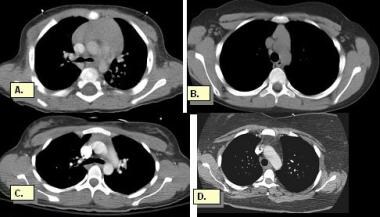Computed Tomography
From birth to puberty, CT scan attenuation of the thymus is comparable to that of the chest wall musculature. The outer contours of the thymus may be convex laterally. The lobes, though separate, may have a triangular shape and may be slightly rotated to the left. The junction between the lobes is about 2 cm to the left of the midline.
From puberty to 30 years age, the overall attenuation value diminishes secondary to fatty infiltration; during this period, attenuation is less than that of skeletal muscle. The thymus is often seen as a discrete triangular or bilobed structure, with the outer borders appearing straight or slightly concave laterally. Changes in the thymus over time are demonstrated in the image below.
 Normal thymus. The thymus is located anterior to the aortic arch, and sometimes 2 lobes can be seen. The thymus is prominent in newborns, occupying most of the anterior mediastinum. After puberty, fat progressively infiltrates the thymic tissue. At age 40 years, the thymus is nearly completely replaced with fat, and only slight residual nodular density of thymic tissue remains. A, Normally prominent thymus at age 7 months. B, Thymus in a 9-year-boy. C, Increasing fatty infiltration of the thymus noted in a 20-year-old man. D, The thymus has involuted and is atrophic in a 38-year-old man. Only a few nodular attenuations are visible.
Normal thymus. The thymus is located anterior to the aortic arch, and sometimes 2 lobes can be seen. The thymus is prominent in newborns, occupying most of the anterior mediastinum. After puberty, fat progressively infiltrates the thymic tissue. At age 40 years, the thymus is nearly completely replaced with fat, and only slight residual nodular density of thymic tissue remains. A, Normally prominent thymus at age 7 months. B, Thymus in a 9-year-boy. C, Increasing fatty infiltration of the thymus noted in a 20-year-old man. D, The thymus has involuted and is atrophic in a 38-year-old man. Only a few nodular attenuations are visible.
After the age of 30 years, remnants of thymic tissue appear as small islands of soft tissue attenuation; these islands appear as linear, oval, or small and round configurations on a background of more abundant fat.
In the older patient, only a thin fibrous skeleton of the thymus remains. At this point, the thymus is almost totally composed of fat.
The most reliable and meaningful measurements of the thymus are related to its thickness. Before the age of 20 years, 1.8 cm is the normal thickness; thereafter, the normal thymus does not exceed 1 cm in thickness.
Comments
Post a Comment